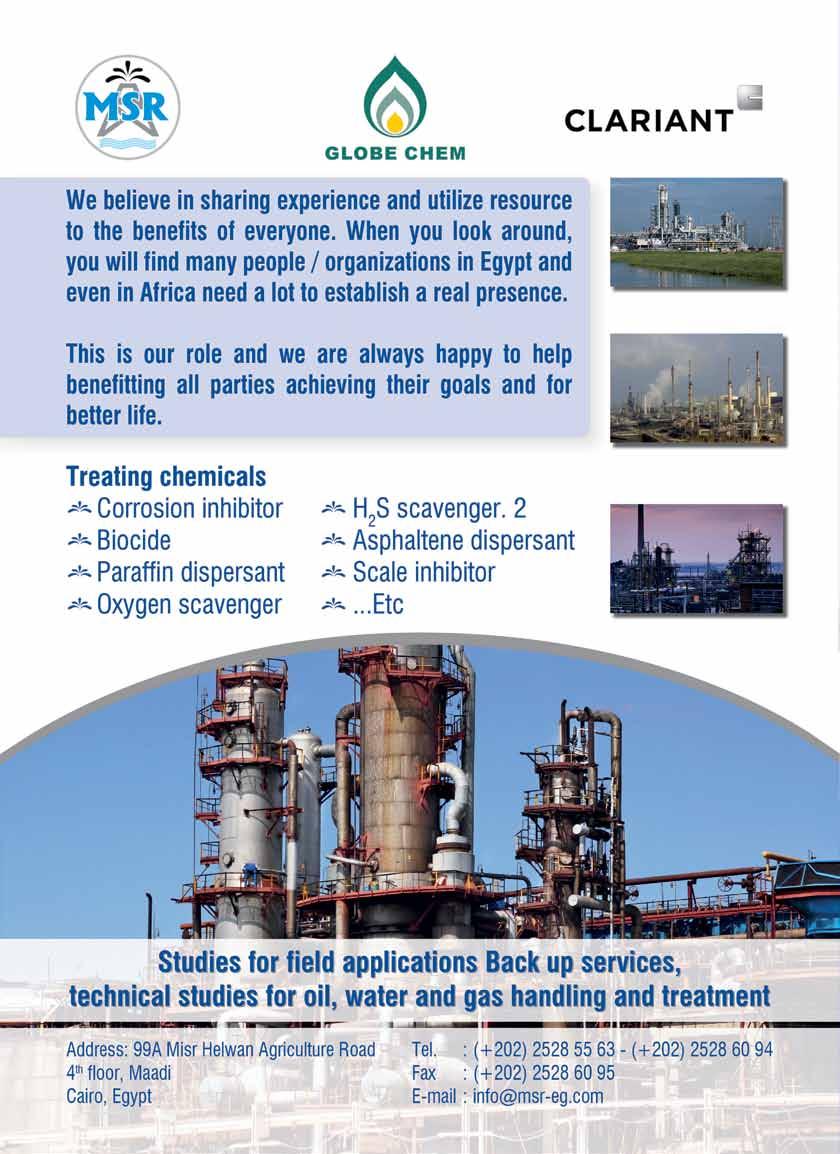
30 minute read
Docking Perforating System with Integrated Real Time Downhole Measurements
AN INTERVIEW WITH Mr. RANDALL C. NEELY, C.A., CFA
President and CEO, Director TransGlobe Energy Corporation
Advertisement
TransGlobe Energy Corporation, in an interview with Petroleum Today Magazine highlights the remarkable strides Egypt has taken to modernize its petroleum sector and the opportunities for further investment, TransGlobe ,s steering strategy towards stable production along with the company ,s aim to expand it ,s operations in Egypt through synergistic acquisitions
Can we update our readers insight on the TransGlobe strategy in light of the current oil market?
Given the ongoing oil price volatility, TransGlobe is continually focused on strict capital discipline through operational cost controls andminimizing our exposure to financial leverage by remaining debtaverse. Despite fluctuations in the markets, we position ourselves as a nimble company with the ability to create value through a balanced portfolio of exploitation, development and exploration opportunities across our diversified onshore assets in Egypt and Canada. This approach has enabled us to build our production base and generate strong cash flows, as demonstrated by recently declaring and payingour first dividend (US$0.035 in August 2018) since 2015.
Where are the most promising areas / concessions the company is working in?
We are most excited about our low-risk development operations in Egypt and are especially focused on the continued expansion of our Eastern Desert Concessions. As such, we are currently working alongside the Egyptian General Petroleum Company (EGPC) to extend the concessions and amend our licenses to encourage the increased development and recovery of the oil in place through secondary and tertiary applications as well as horizontal drilling and multi-stage completions. Subject to approval from the Egyptian government, the amendments sought should allow for improved efficiencies and increased reserve recovery from known oil pools through enhanced recovery techniques.
TransGlobe has been working in Egypt for more than a decade, what are some attractions in the Egyptian petroleum sector?
The production and distribution of oil is an integral part of Egypt’s economy and the country has developed a well-established service industry to support exploration and development operations, exemplified by the increasingly large and talented workforce. This presents an exciting opportunity for TransGlobe to operate within. On the other hand, the challenges that we face include inflexible contract terms that aren’t always reflective of the underlying assets and varying interpretations of any grey areas. Nevertheless, the leaders within the Ministry and EGPC are admirably working towards modernizing the industry which should lead to a stronger and more investible operating environment.
What is the amount of TransGlobe`s 2019 allocated budget here in Egypt with reference to other countries? And how many wells do you plan to drill during the current calendar year?
Our 2019 capital program equates to $34.1 million (before capitalized G&A), which includes $24.1 million for Egypt and $10.0 million (C$13.0 million) for Canada. This plan is strategically aimed at maximizing free cash flow to direct at future value growth opportunities in Egypt and outside of Egypt. This strategy is also in line with our 2018 drilling campaign where we drilled eight development wells in Egypt – 4 in West Bakr, 2 in North West Gharib and 2 in West Gharib – compared to six development wells in Canada.
What is the operational update on the South Ghazalat exploration?
We recently announced in our 2018 yearend reserves update that a successful discovery at South Ghazalat and successful extensions at West Bakr resulted in positive additions of gross 2P reserves of 2.1 MMboe. Based on the positive test rates from South Ghazalat, we are in the process of preparing a development plan for the discovery. In addition to this, we are also integrating the well results into our existing database and mapping to evaluate further exploration / appraisal drilling opportunities in the area to accelerate potential early development options and hopefully lead to additional discoveries.
What is the growth strategy of TransGlobe worldwide and in Egypt?
We are primarily focused on development and production with a core view of generating strong cash flows and longterm value accretion. By steering the bulk of the company’s efforts towards stable production, we have been able to create a uniquely competitive position in the market. Given our strength in looking at older, under-loved and under-developed assets, we cancapitalize our individual skillsets to improve field rejuvenation possibilities. Further to this, we are also looking to expand our operations in Egypt or similarregions through synergistic acquisitions, and in doing so, we hope to triple our production output and more importantly cash flow in the medium term. Having said that, having a little exploration success along the way is always welcome.
Why did you exit the business in Canada then decided to re-enter the business in 2015?
Our decision to exit and later re-enter Canada came from a strategic desire to diversify our portfolio of development assets and gain exposure to the increasing technological advancements in North American drilling and completion techniques. Our Canadian re-entry was part of the Company›s ongoing strategy of portfolio diversification into countries with attractive netbacks to support growth. This decision inevitably played to our core strength of value creation through development drilling and reservoir management.
What are your plans to mitigate oil price downturn?
We have been able to weather unpredictable markets by maintaining control over our own operations and focusing on opportunities where we can operate most efficiently. Because we are the operator of all our Egyptian assets and the majority of our Canadian assets, if oil prices shift materially we can react quickly. We’re not forced to push ahead when it isn’t favorable to do so and we can therefore control our costs accordingly. Conversely, in periods of rapid price appreciation we are able to move swiftly in order to capitalize on those opportunities to our greatest benefit.
You have a great journey with different positions and exposure, we would like to hear your story?
I was born in Eastern Canada but spent my formative years in the Yukon Territory, where I established many close friends that I still have today. Post high school I spent a few years working odd jobs, including an oil exploration supply ship in the Arctic Ocean, and traveling. That traveling brought me to Egypt for the first time in 1986, when I visited Cairo, Aswan and Luxor, an amazing experience for a 19 year old. Realizing I couldn’t travel and work odd jobs the rest of my life, I enrolled in Business at the University of Calgary, graduated in ‘92 and joined the chartered accounting firm of KPMG in Calgary. Following that I spent about four years as an energy investment banker until one of my clients enticed me into the energy business where I have been ever since.
Finally, we would like to know about TransGlobe CSR policies and activities in Egypt?
TransGlobe have been supporting the Ras Gharib hospital for many years, as a recipient of choice as suggested by our Joint venture employees. Our production assets are close to city of Ras Gharib on the Gulf of Suez and a large number of our joint venture employees live in Ras Gharib and have a strong attachment to the hospital. In 2013, TransGlobe provided support to of fund the establishment of the first intensive care unit at the hospital and we continue to support the unit with donations to fund the acquisition of specialist heart and lifesaving equipment on a regular basis. TransGlobe makes the donations to the hospital whenever a significant HSE achievement is reached so that we are improving safety continually as well as supporting an essential local facility in Ras Gharib. In addition to this, TransGlobe has 2 staff members on the CSR committee, which is a subcommittee of the Egypt oil and Gas technical committee. Although only recently formed, this committee is already very active in liaising with other IOC’s to share and align CSR activities across the industry.
Technology Applications
Docking Perforating System with Integrated Real Time Downhole Measurements
By: Carlos Eduardo Guedes, Marcia Benavides, Carlos Baumann, Fernando Garcia-Osuna, Sharif Aboelnaga, Zouhir Zaouali, Said Al Rasbi, and Moises Smart, Schlumberger
Abstract by increasing safety, efficiency and reliability, while at the This paper presents field results of the first same time maximizing productivity. well perforating system integrated with a This instrumented gun system can be deployed with wireline, depth correlation and real time high-speed tractor or electrical coil tubing. The new docking gun system measurements device, this tool acquires design reduces human error and the risk of wellsite accidents and transmits downhole data to surface in real time while and failures. With this system we also maximize gun length perforating. The docking gun system with plug-in design deployment per run and operational efficiency. In addition, improves operational safety, efficiency and reliability, real time downhole measurements of low- and high-frequency whereas downhole measurements help to obtain maximum wellbore pressure allow optimization of perforating cleanup well productivity by providing real-time downhole wellbore and stimulation, maximizing productivity and reducing the pressure, transient dynamic underbalance and/or overbalance overall cost per barrel produced. for perforation cleanup and/or well stimulation. The new perforating system consists of two main components: a docking gun system and an advanced measurements module. The docking gun system consists of a compact, plug-in, radio frequency safe, addressable firing system for single and multi-zone sequential perforating applications. The system eliminates port plugs and wellsite arming of detonators, reducing human error and improving overall safety, efficiency, and reliability. The advanced measurements module provides high-frequency transient wellbore pressure, peak acceleration amplitude, and low frequency pressure, temperature, gamma ray, and active casing collar locator. These measurements enable real time confirmation of downhole conditions before, during, and after perforating, with accurate depth correlation even in high chrome tubulars and large casing sizes. This instrumented docking gun system delivered an outstanding field performance, adding value to operators
Introduction
Establishing an optimum flow path between the reservoir and the wellbore is the main objective of perforating not only for natural completions but also for wells that are to be fractured, stimulated, gravel packed, etc. Explosive shaped charges are the most common tool to puncture the casing, cement, and reservoir rock. Perforating with shaped charges is an extremely fast event which only lasts milliseconds. Perforating technologies have evolved from just making holes in the casing to customized perforating designs depending on the reservoir properties and well type. Perforating designs cover all aspects of the job, from selecting the best perforating charges to recommending the best perforating method, such as perforating without killing the well and conveyance of long gunstrings on wireline. By the end of the 20th century, manufactures and operators
were focused on API 19B Sect 1 performance. The 2000,s saw the advent of perforating with dynamic underbalance (DUB) for perforation cleanup (Behrmann et.al., 2002). By the end of the 2000,s the industry recognized that focusing on API 19B Sect 1 penetration performance was not the right measure because charges could be good performers in concrete (Sect 1) but have a bad performance on real reservoir rock under stress (Baumann et.al. 2015). Therefore, during the last decade the industry has moved to Section 2 performance, rock models and rock optimized charges as well as unconventional reservoirs (Behrmann et.al., 2009). In terms of operational efficiency and reliability, plug and play gun systems were first developed for unconventional multistage fracturing, and extended to all type of operations to facilitate gun arming at the wellsite with minimum risk of misfires or misruns (Aboelnaga et.al., 2016, 2018). At the same time, the effects of gun shock on downhole tools and equipment were extensively studied and modeled, and gunshock simulation became an essential part of every perforating job design (Baumann et.al., 2012, 2014). This paper presents field results of the first docking gun system integrated with a depth correlation device capable of acquiring real time downhole measurements while perforating. The gun system improves operational safety, efficiency, and reliability with a plug-in design, whereas the real-time downhole measurements allow for productivity maximization by confirming static and dynamic underbalance for perforation cleanup, and dynamic overbalance for stimulation applications.
Docking gun system with real-time downhole measurements
The need to prevent perforating failures such as a misruns or off-depth perforations has always existed. Many systems have been developed with the goal of reducing perforating non-productive time (NPT), and indeed many systems have reduced perforating related NPT, however, misfires, misruns and even surface detonation events still frequently occur. A breakthrough development became available in 2018, the first docking gun system (see Figure 1) integrated with an advanced measurements module (see Figure 2) depth correlation device capable of acquiring real time downhole measurements while perforating. This innovative technology consists of two main parts: a docking gun system and an advanced measurements module capable of acquiring and transmitting to surface downhole data, in real time while perforating. To radically increase the number of runs per misrun in radio frequency (RF) sensitive environments, the new docking gun system shown in Figure 1 was introduced, this technology has helped to increase perforating reliability by drastically reducing perforating NPT, and being RF safe. This new system prevents typical wireline perforating misruns with a «plug-and-play» system that eliminates most human related errors (wiring and seal failures) and prevents initiator related failures and RF-triggered initiations, the system safety has been certified by a third-party independent lab. This docking gun system is currently available in three sizes: 2 -7 / 8», 3- 3 / 8 », and 4 - 1 / 2» OD, all rated at 350 F and 25,000 psi. The system›s advanced measurements module (see Figure 2) provides reliable depth correlation and several measurements prior, during, and after perforating. The measurements module consists of two components: the primary assembly which includes an active Casing Collar Locator, Gamma Ray, Temperature, and slow- and fast-frequency Pressure measurements, as well as Peak Shock. The tool OD is 2 - 7/ 8 » and it is rated at 350 F and 20,000 psi.
Main applications and benefits of the instrumented docking gun system
The combination of the advanced measurement module and the docking gun system increase productivity, safety, reliability, and operational efficiency. These benefits are described below.
Productivity
The advanced measurements module provides, among others, low- and high-frequency transient wellbore pressure. These measurements allow real time confirmation of downhole conditions before, during and after perforating, which are beneficial on any conventional perforating activity, and very important when seeking dynamic underbalance when perforating or stimulating wells post perforating.
Dynamic Underbalance (DUB).
Dynamic Underbalance Perforating (DUB) is a patented technique used to obtain clean perforations (Behrmann et.al., 2002, 2009, Baumann et.al. 2015). DUB is a technique used to control downhole well dynamics and it is a combination of perforating gun system and completion design to remove perforating tunnel debris and reservoir rock damage: Ó Formation rock crushed zone is removed by tensile failure caused by a high differential pressure between reservoir and wellbore. Ó Formation fines are removed by surge flow into the wellbore because of a high differential pressure between reservoir and wellbore (dynamic underbalance or drawdown). Ó Dynamic underbalance at the sand face is key, we should not confuse this with other systems that only show a
pressure drop at the entrance to surge chambers. The advanced measurements module provides real-time instrumentation that plays significant role in understanding and controlling the perforating job from start to finish: Ó While running in the hole, hydrostatic pressure gradient is used to check wellbore fluid levels and hydrostatic assumed in the DUB design. Ó While correlating both gamma ray and active CCL measurements provide accurate gun position to place the guns at the desired pay zone location. Ó Prior to shooting, static pressure measurement is compared with the DUB perforating design, and hydrostatic pressure can be adjusted to get the highest dynamic underbalance for perforations cleanup to maximize productivity. Ó Measuring the DUB at the very moment the guns are shot to confirm DUB amplitude and duration, checked against the DUB model to make sure modeling and actual results are close enough, and adjust if needed to optimize the perforating job in subsequent runs. Ó The gun string can be left for some time downhole to measure the buildup pressure to estimate reservoir pressure and skin. Post Perforating Dynamic Underbalance. The post perforating DUB technology consists of using surge chambers to expose existing perforations to a high differential pressure between the wellbore and the reservoir. Typically, no new perforations are created, although it is perfectly possible to add perforations in the same run when the post perforating DUB is done. The objective is to clean dirty perforations and/or remove the crushed reservoir rock left when perforating without DUB. The design of post perforating DUB jobs is like a perforating DUB job. The wellbore and formation parameters are used to design the gun size and density of gun carrier opening charges to be used. Job execution at wellbore conditions assumed in the design is very important for the success of the operation. The advanced measurement module plays a key role by providing real time downhole measurements, thus ensuring optimal conditions are set before shooting the guns and registering the transient DUB to confirm DUB amplitude and duration (high frequency measurement) for perforation cleanup. Lower frequency pressure and temperature values are available all the time while the tool is in the well, therefore this data can be used to quantify productivity gains.
Safety
Perforating with explosive shaped charges poses a significant operational risk to all personnel exposed to explosive charges. In the last 20 years, the industry has seen a very large number of surface detonations, some are reported on the public website www.perforators.org where we found 70 surface detonations events. Consequences of these events are catastrophic to all personnel, assets and companies involved. Over 50% of surface detonations took place due to inadvertent application of power to the gun detonators. The docking gun system has been designed with two important safety features that, by design, eliminate the risk of unintentional detonation events at surface and downhole. These safety features do not need or rely on users, adherence to procedures to prevent surface detonations. First safety feature is addressable switch technology on the docking gun system, which uses an electronic chip to communicate with the detonator, eliminates the risk of accidentally powering the detonators. In upcoming years this system is expected to become an industry wide minimum safety requirement. The second safety feature is wideband filtering to protect against radio-frequency, allowing perforating without switching off cellphones, hand-held radio, or any other radio frequency transmitters. The system has been tested and certified by an independent third-party organization. The measurements module is also fitted with a safety protection system. Logging with perforating guns poses the risk of power leakage from the logging tools to the perforating tools, which could cause an unintentional detonation. The measurements module was designed with a dual safety barrier which enables data acquisition before, during and after multiple perforating events ensuring the guns are electrically isolated from logging power.
Reliability
Key driver for the docking gun system was the industry need for a more reliable system. A failures analysis (Aboelnaga et.al. 2018) revealed that conventional systems mainly fail at seals, and at electrical and ballistic connections and transfers. To address these challenges many features were implemented in the docking gun system and the measurement module. All the docking gun system module connections are done and tested at the manufacturing facility. This eliminates the human factor when crews need to arm guns at the wellsite, affected by weather and psychological conditions. The elimination of scotch locks and field crimping operations was key to enable a step change in reliability. The need to cut and crimp primacord in the field was also eliminated. The docking module provides a side by side transfer from the detonator to the primacord. Additionally, all the side ports were eliminated with the
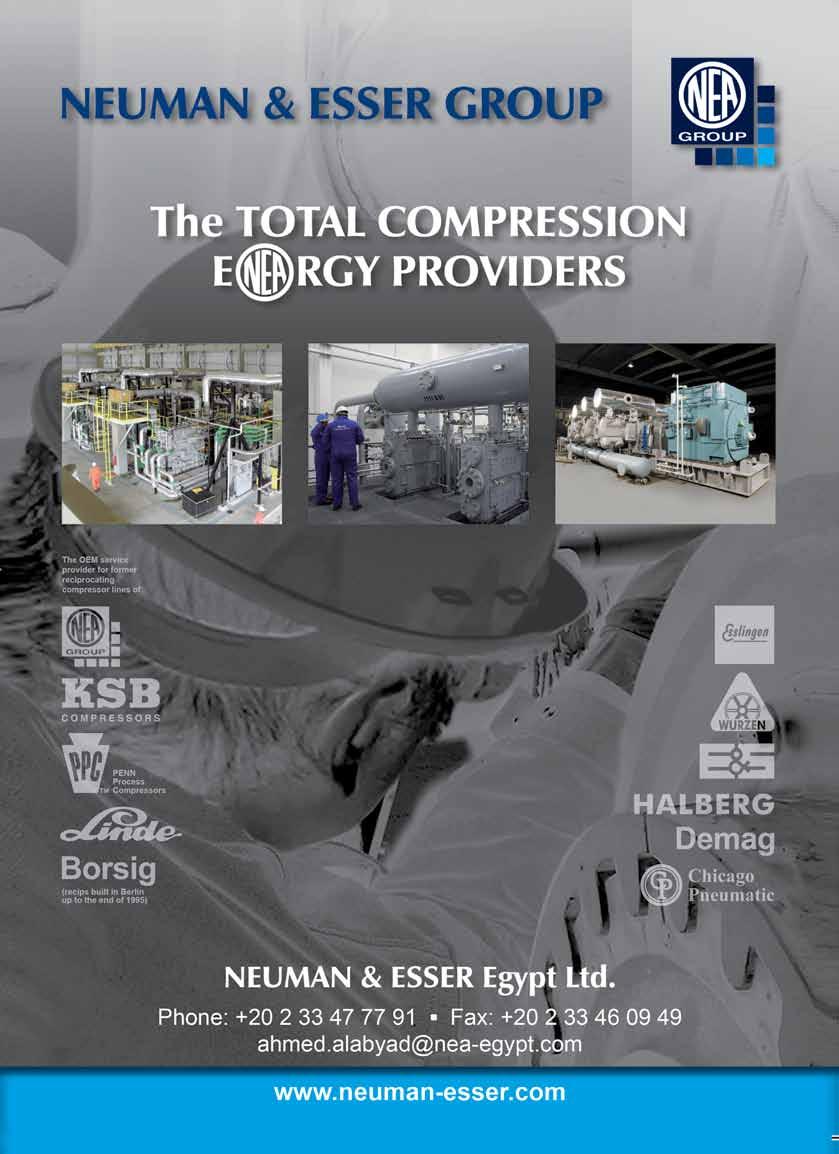
potential for leaks that cause misruns. For single initiation runs the field does not need to be involved with any wiring operation because the only electrical connection made at the field is a coaxial connection, RCA type, which is done when the top sub is threaded on the gun. For multiple initiation runs the selective wires are connected through an IDC type connector using a simple hand tool. On both cases, all connections and switches are checked with a designated test box prior to running in hole. Finally, the data acquisition system can communicate with the docking gun system from 200-ft below ground level all the way to shooting depth. With this technology problems are detected at surface or soon after they occur while running in hole, saving a lot of time when compared with conventional systems. The measurements module has ruggedized electronics and sensors which eliminate the need for shock-absorbers.
Efficiency
Perforating efficiency is critical whenever the daily cost of rigs is high, when production is on hold or delayed, when other operations such as hydraulic fracture are on standby, and in most other scenarios nowadays when the oil industry is working on very tight profit margins. The instrumented docking gun system increases efficiency by increasing the effective perforated length per run, reducing preparation time at surface, and by eliminating NPT as described before. The effective perforated length per run was increased because of 4 main components. First, the measurement module is only 60-in long, much shorter than other technologies used to measure pressure, temperature, gamma ray and collar location while perforating. Second, shock absorbers are not needed, which allows additional gun length to be deployed, increasing the perforated length per run and reducing the total number of runs required for the job. Third, selective gun adapters on this system are on average 12 - in shorter than previous versions, this again allows additional gun length to be deployed. Finally, the measurement module measures the peak shock, which is very important in jobs where the number of guns fired simultaneously is limited to ensure weakpoint survivability, this shock measurement can help to evaluate the merging of safety and possibly to increase the simultaneously fired gun length. Surface preparation time is lower with a plug-and-play approach that simplifies arming the guns. The docking module connections from detonator to addressable board is done at the manufacturing facility. Additionally, a safer docking gun system circuit design allows arming the guns before starting the actual the perforating job, simultaneously with other well work, this eliminates the arming time from the needed rig time (critical path).
Test Results
The new instrumented docking gun system was tested in 9 countries, in 2018 more than 200 operations were executed. The advanced measurement module was extensively used in Ecuador, where 4 tools were deployed, and a total of 38 jobs with 83 runs were performed. Figure 4 shows number of runs per job type and per gun size.
Some of the operational highlights/records achieved were:
Ó Time savings in arming, loading, and connecting/testing selective strings. Ó Robustness was tested even with 7-in guns, including propellant perforating, and always without using shock absorbers. Ó Heaviest perforating tool string: 40 ft of 7-in guns Ó Maximum number of runs per job: 7 Ó Dynamic events recorded in every job, low- and highfrequency recordings, which were available in real time at the well head. This established a step change in performance and reliability when compared with thirdparty memory fast gauges which only give saved data after the job. Low- and high-frequency dynamic measurements while perforating allowed operators, field personnel, and perforating specialists to: Ó Measure downhole conditions before and after perforating to validate hydrostatic pressure on the first and subsequent runs, changing hydrostatic after perforating to determine reservoir pressure, in many cases reservoir pressure was substantially different from the values assumed. Ó Real time high-frequency pressure measurements were used for all types of jobs, see Figure 5. Ó Real time fast pressure measurements while perforating provided a direct way of comparing the simulation results with the actual job DUB or dynamic overbalance pressure, in all cases the match between actual job data and simulations was close enough for cleanup estimates, see Figure 6. Ó An important enhancement to gas fracturing / propellant stimulation jobs is the new highfrequency wellbore pressure measurements. The energetic dynamic overbalance event often damages conventional fast memory gauges, with the advanced measurement module the success rate has been 100%, allowing analysis / verification of the stimulation job, including propellant burn parameters and formation injectivity, which are used to improve job designs and productivity estimates. Figure 7 shows a comparison
between a simulation output (left) and real-time wellbore pressure measurement (right), the latter was used to infer reservoir permeability. In Oman the advanced measurements module was successfully deployed in 39 jobs, firing both selectively and non-selectively. Many wells were simultaneously perforated and stimulated with 4.5» HSD guns loaded with propellant sleeve installed on the gun carriers. Wellbore hydrostatic pressure data was continuously obtained while running in hole, this is essential information before propellant stimulation to ensure that enough confinement pressure is available for a successful well stimulation job. Once again, the tool proved perforating shock robustness, the tool was run in many jobs with 4.5» HSD guns loaded with propellant sleeve, and without a shock absorber. High-frequency wellbore pressure was always recorded in real-time, for example Figure 8 shows the propellant stimulation peak pressure used to confirm the dynamic overbalanced achieved. In the Kingdom of Saudi Arabia, the advanced measurement tool was successfully run with 2 - 7 / 8» HSD guns. Perforating was done in high temperature tight gas reservoirs, applying 300 psi of static underbalance (UB) to create clean perforations without formation damage. Typical perforating runs included: Ó Record low-freq GR, CCL, pressure and temperature data while RIH. Ó Depth correlation at target perforating depth. Ó Fire, high-freq dynamic pressure data automatically recorded together with other job parameters. Ó Record low-freq wellbore pressure buildup (BU) (few hours). Ó Record low-freq wellbore pressure and temperature while
POH. Jobs were completed successfully. Feedback from real-time downhole measurements: Ó In one case wellbore pressure gradient before perforating indicated poor mud displacement across the target zone, this helped the operator to re-design the CT mud displacement in subsequent wells. Ó After perforating, in one case the low-freq wellbore pressure indicated a wellbore overbalance with respect to the formation, which is not desirable because of the formation damage risk. We must revise the assumed reservoir pressure to make sure that jobs are executed with an initial static underbalance. Ó After perforating, in one case the low-freq wellbore pressure indicated a very large wellbore static underbalance with respect to the formation, which is not
desirable in a gas well because of the risk of blowing the guns uphole. We must revise the assumed reservoir pressure to make sure that jobs are not executed with an initial static underbalance that is too large and poses an operational risk. Based on the experience gained from multiple runs in the Kingdom of Saudi Arabia, our client prefers DUB over static UB, DUB jobs (tradename PURE) are considered the best option to get wells with low skin. The advanced measurement tool capability to get real-time downhole data and confirmation of firing in multi-stage perforating jobs was used to optimize perforating jobs, real-time data was used to update the stimulation model. A few jobs have also been successfully completed in the following countries: Ó Colombia: the measurement module was just introduced, only two jobs so far. Ó United States (Alaska): 4 runs with 2 7 / 8» and with 3 3 / 8» docking guns and measurement module, Ó all jobs successfully completed, and maximizing operational efficiency. Ó Kuwait: 8 runs including the measurements module, all jobs successfully completed. Ó Australia: 15 runs with the 3 3 / 8» docking gun system and measurement module, all jobs successfully completed. Ó Egypt: 17 runs with 2 7 / 8» docking gun system, all jobs successfully completed. Ó Algeria: 30 runs 2 7 / 8» docking gun system, all jobs successfully completed, and in all cases maximizing operational efficiency.
Conclusions
The new instrumented docking gun system delivered an outstanding field performance, adding value tooperators by increasing safety, efficiency and reliability, while at the same time maximizing productivity. The new docking gun system design reduces human error and the risk of wellsite accidents and failures, and it can be deployed with wireline, tractor or electrical coil tubing. This system maximizes gun length deployment per run and operational efficiency, and the downhole measurements of low- and high-frequency wellbore pressure in real-time allow optimization of perforating cleanup and stimulation, maximizing productivity and reducing the overall cost per barrel produced. The RF-safe docking gun system has delivered 100% reliability even when used under extreme conditions, from artic to desert environments, including downhole temperatures reaching 340F. Customers benefited from
reduced operational times, lower number of runs per job and no misruns translate into significant rig time savings, less time to production and lower logistic costs. Operators have also benefited from more downhole measurements and accurate correlation, real-time measurement of downhole hydrostatic pressure before shooting, and real-time highfrequency downhole pressure to assess perforation tunnel clean up that lead to lower skin and higher production.
Summary of performance results from more than 200 jobs executed to date:
Ó Quick, safe and reliable docking plug-in guns eliminated arming time and reduced operational time. Ó Real time pressure and temperature measurements allowed verification of wellbore conditions before perforating, and whenever needed adjustments before perforating, thus preventing formation damage and / or other non-optimal perforating conditions. Ó Real time downhole pressure and temperature measurements after perforating allowed to evaluate well response. Ó High frequency pressure measurements while perforating provided actual dynamic underbalance and/or overbalance, necessary to validate job designs for optimum perforations clean up (DUB job) and/or stimulation (propellant jobs). Ó Perforating with up to 40-ft of 7-in guns demonstrated the robustness of the measurement module, without using shock absorbers. Shock measurements reached accelerations of over 50,000 G and provided input data to plan challenging perforating operations.
Acknowledgments
The new perforating tools described in this paper have been possible thanks to SLB R&D and all the people on locations around the world who tested and used these new tools over the last year.
Nomenclature
HSD High shot density DUB Dynamic Underbalance (marketed by Schlumberger as PURE) NPT Non-productive time SPF Shots per foot
REFERENCES
Aboelnaga, S., Salsman, A., Martin, A., Singh, K., Pandey, A., & Guedes, C. E. (2016, August 22). Expanding the Reach of Wireline Perforating. Society of Petroleum Engineers. https://dx.doi.org/10.2118180668-/MS Aboelnaga, S., Austin, D., Garcia-Osuna, F., Goodman, K., Fayard, A. J., Bouloudene, S., & Mohamed, Y. (2018, March 27). New Initiation System
Delivers Improved Perforating Safety and Reliability While Maximizing Efficiency.
Society of Petroleum Engineers. https://dx.doi.org/10.2118189936-/MS Behrmann, L. A., Hughes, K., Johnson, A. B., & Walton, I. C. (2002, January 1). New Underbalanced Perforating Technique Increases Completion
Efficiency and Eliminates Costly Acid Stimulation. Society of Petroleum Engineers. https://dx.doi.org/10.2118 / 77364 - MS Behrmann, L. A., Grove, B. M., Walton, I. C., Zhan, L., Graham, C. A., Atwood, D. C., & Harvey, J. P. (2009, January 1). A Survey of Industry Models for Perforator Performance; Suggestions for Improvements. Society of Petroleum
Engineers. https://dx.doi.org/10.2118125020-/MS Baumann, C. E., Benavides, M., Martin, A. J., Salsman, A. D., & Williams, H. A. R. (2012). Perforating on Wireline -
Weak-Point Load Prediction. https://dx.doi.org/10.2118152431-/MS Baumann, C., Gultom, D., Williams, H., Yudhatama, A., & Rahman, R. (2014). Wireline Perforating Technology Maximizes Well Productivity and
Minimizes Operational Risks. https://dx.doi.org/10.2118 / 1693 22 - MS Baumann, C., Gultom, D., Salsman, A., Smart, M., Primasari, I., Rahman, R., & Warsito, S. (2015, June 3).
Perforating on Wireline: Maximizing Productivity and Minimizing Gunshock. Society of Petroleum Engineers. https:// dx.doi.org/10.2118174213-/MS Guedes, C. E., & Aboelnaga, S. (2018, September 1). Technology Update: New Instrumented Docking Gun System
Maximizes Perforating Performance. Society of Petroleum Engineers. https://dx.doi.org/10.21180024--0918/JPT Al Busaidy, A. M., Zaouali, Z., Baumann, C., & Vegliante, E. (2011, January 1). Controlled Wellbore Implosions Show
That Not All Damage is Bad. Society of Petroleum Engineers. https://dx.doi.org/10.2118 / 144080 - MS

Since 2003, flow measurement Systems Company has been established according to the investment authority laws and executive regulations to serve the oil &gas sectors as well as industrial & commercial sector in Egypt & the region to provide hydro test and calibration services. We are accredited by the ILAC, based on the international mutual recognition arrangements (MRA), under the guidelines of ISO/IEC 17025 for general requirements for competence of calibration and testing laboratories. We are certified ISO 9001, OHSAS 18001 and ISO 14001. The ILAC is the peak international authority on laboratory accreditation. Laboratory accreditation provides our clients with formal recognition of the competence of our laboratory. We are re-evaluated regularly by the accreditation body to ensure our continued compliance with requirements. Thus, being accredited is highly regarded both nationally and internationally as reliable indication of our technical competence. Accordingly our data is readily accepted overseas.

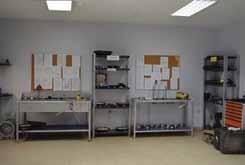
PRESSURE TEST (Hydrostatic & Pneumatic)
Ó Fully computerized and plc controlled test unit, capable of building pressure up to 30,000 psi by using two air-driven pumps, one for quickfilling and the other to build up pressure to the test value. Ó The pressure test Monitored digitally on system wide screen and recorded on paper charts to issue full test report. Ó Camera system is installed for monitoring the test and observing any leakage. Ó The test unit operated with remote control systems in a safe Test Area.
PRESSURE SAFETY VALVE CALIBRATION AND TESTING
We undertakes Inspection, Overhaul, Calibration and Certification of all types of Pressure Relief Valves AS (A SAFETY RELIEF VALVES , PRESSURE SWITCH And PILOT VALVES ) with high accuracy equipments( Ventill test unit , Haskel gas boosters , pressure sensors ) FMS carries out these jobs according to procedures developed ‘In House’ conforming to the requirements of BS EN ISO4126 : 2013, API-527, API-598 and API 576 standards.
AIR BLOWING
Objective :
Air blowing services as an efficient way to remove construction debris, loose rust, liquids, and other contaminants from process piping.
Application processes :
Ó Air Flushing for piping diameters less than 6”. Ó Air Blowing (Buffing) for piping diameters bigger than 6”.
FMS INTEGRATED CONTROL
Everything you need for your Automation and Control Systems Ó Control Panel Design & Fabrication. Ó Programmable Logic Controllers (PLC). Ó OIT‘s (Operator Interface Panels) or HMI’s (Human
Machine Interface). Ó Pondhop automation and control systems. Ó Process Plant Troubleshooting & Engineering Problem
Solving.
Q2-0101
FLOWMEASUREMENTSYSTEMS(FMS) 177Fifth&SixthDistrict,IndustrialZone,ZahraaAlMaadi Cairo Egypt
CalibrationofPressureWorkingDevices;InspectionofSafety-RelievingDevices; ProvisionofLiquidandGasPressureTestServices
NoExclusionsIdentifiedasApplicable Contact Persons:
Khaled abdeltawab
General Manager 012 2364 0198 K.tawab@fms.com.eg admin@fmseg.com
Sayed Ahmed
Financial Accountant 01211122494 f1@fmseg.com fm@fmseg.com
CALIBRATION SERVICES
Ó Calibration for pressure gauges up to 30 KPSI (Analog & Digital). Ó Calibration for pressure recorder (Renting and repair). Ó Calibration for tong torque and tong line pull systems. Ó Calibration for silo tanks weight indicator systems. Ó Length measurement tools (verniercalliper- micrometers) Ó Calibration for with different kind and ranges of torque wrenches. Ó Calibration For All Kind Of Pressure and Temperature
Transmitters and transducers.

PIPELINE SERVICES
Equally applicable to new build modules as well as existing plant , good flange management can provide a single point source of all information relating to the history, make up or any other relevant details relating to all flanges within a system.
Applications:
Ó Used during engineering construction, commissioning and shutdowns Ó Flange break register during shutdown and maintenance
Mahmoud Rashwan
Service Quality 01211122491 qhse@fmseg.com
Mazen Mohammed
Business & Development 01211122496 op@fmseg.com
Mahmoud Hamed
lab workshop specialist 01211122495 ls@fmseg.com
Anawr asharf
Senior engineer 01273773385
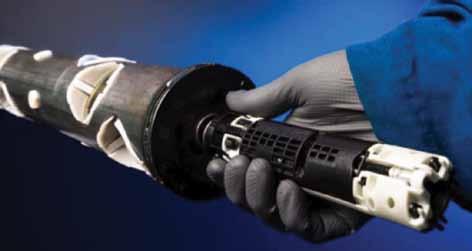
Figure 1—Innovative Docking Gun System
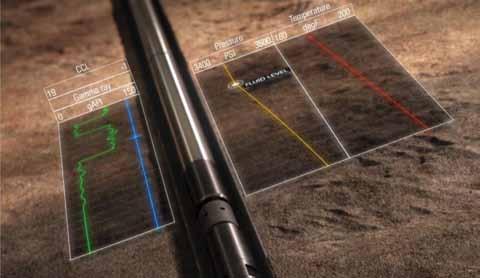
Figure 2—Advanced Measurement Module
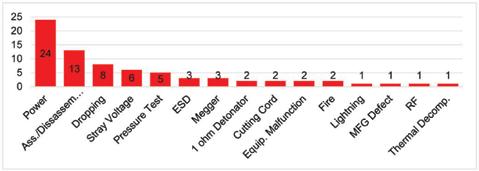
Figure 3—Last 20 years surface detonation events reported in perforators.org
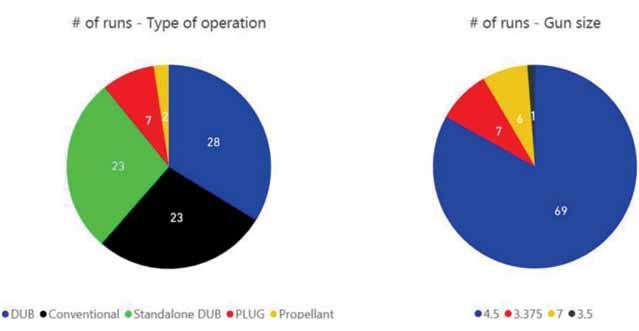
Figure 4—Operations in Ecuador - Job type and gun size break down

Figure 5—Different applications of the measurement module
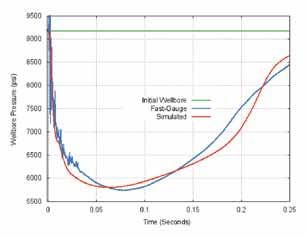
Figure 6—High-frequency pressure data and predicted transient pressure at the gauge location

Figure 7—Dynamic pressure response: simulated and actual real-time high-frequency measurement
Figure 8—High-frequency pressure measurement in real time - propellant peak pressure

